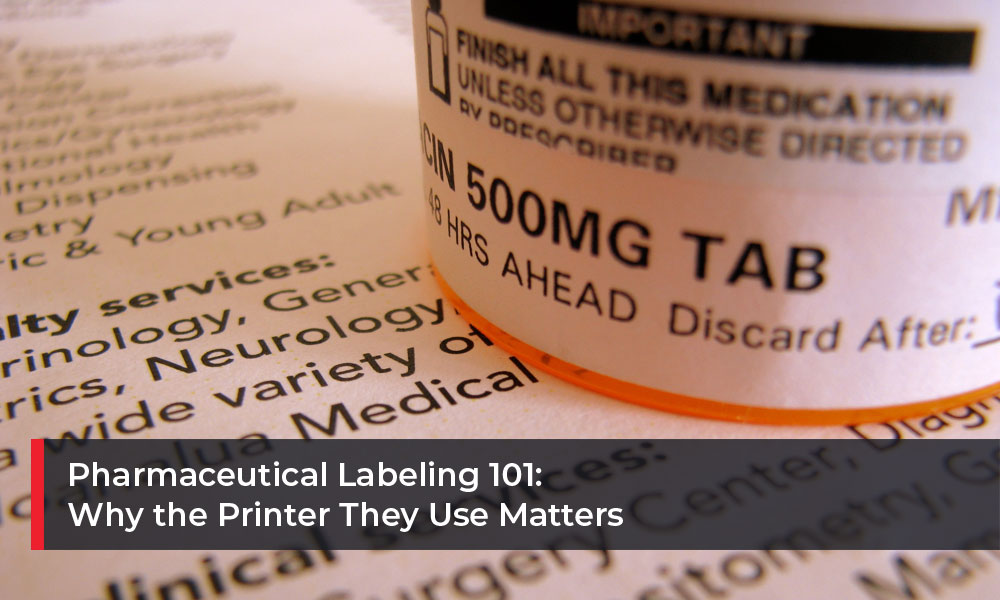Printing is a natural part of business, but there are many instances when it’s a high-stakes activity with severe repercussions if a company gets it wrong. One of those instances is pharmaceutical labeling. In addition to the stringent and specific requirements outlined by the FDA, labels require uncompromised quality, crystalline legibility, and ultra-specific formatting before it can be released to consumers.
Clear labeling is critical for pharmaceutical companies, but a surprising dearth of information exists on the printing practices of label suppliers. Read on to discover the seven printer-related things healthcare organizations must consider when they’re shopping for a pharmaceutical labeling supplier – and how these relate to the printers the supplier uses.
7 Things to Consider When Shopping for a Pharmaceutical Labeling Supplier
According to the FDA, label mix-ups accounted for just over 11 percent of all labeling recall events in 2014 – a number that has remained consistent over the past five years. Label accuracy is crucial to ensuring that consumers receive the correct medicine in correct doses. However, even when all the information is accurate, there are still numerous considerations for pharmaceutical labeling. When shopping for a labeling supplier, look for one that emphasizes:
1. Diligence to Accuracy Regardless of Label Type
Diligence and an unwavering commitment to accuracy must stand among the top priorities for pharmaceutical labeling suppliers. The FDA requires that companies issue recalls for any typos, no matter how insignificant they may seem. At best, this may prove a source of embarrassment for a company. At worst, it can result in product delays, revenue loss, and distrust from consumers.
2. Process Optimization
When it comes to labels, no label is the same. From certified substrates to specific inks, a label printer needs to handle all the intricacies of FDA labeling requirements. Therefore, look for a supplier who emphasizes process optimization, either through automation in their workflow or devices that handle specialized settings easily.
3. Image Quality
Label printers require the highest level of image quality available on printers – this means investing in digital presses equipped with advanced features like dry toner. With this technology, a printer can achieve resolutions up to 1200 dpi consistently, something that’s far out of range for most devices.
4. Brand Protection Features
Unlike other industries that rely heavily on printers, the pharmaceutical industry must combat counterfeiting with its labels. Brand protection like raised images, micro text, and advanced watermarking help ensure that a brand remains unique – and counterfeiters get spotted. Often, these features require advanced finishing options that are only available on production or industrial printers.
5. Traceability During Manufacturing & Serialization
Traceability supports transparency. A good label printer will deploy tracing throughout the manufacturing – from sourcing raw materials to the final proof. There are a variety of strategies to accomplish this. Many document management and enterprise content management suites can keep a close eye on orders during the manufacturing process in near real-time by integrating with printers that support it.
Additionally, since 2013, the FDA has required serialization on pharmaceutical labels under the Drug Supply Chain Security Act (DSCSA). This act outlined the steps for a label printer to build an electronic, interoperable system to identify and trace certain prescription drugs. Originally designed to prevent counterfeiting of both pharmaceuticals and their labels, it seeks to improve the overall traceability of pharmaceutical components by providing each with a unique serial number.
6. Complete Reporting and Other Compliance Requirements
In addition to transparency, traceability also supports order reporting. FDA compliance regulations require documentation with every order to prove that labels were created to the specifications they demand. Likewise, a label printer using an ECM suite will have the tools in its hands to automate the sending of these reports, plus the creation of digital copies to support backups and rapid dissemination.
7. No Downtime Disaster Recovery
Pharmaceutical printers are already under pressure to deliver flawless labels rapidly. They must also be able to do this following a disaster without suffering downtime. Otherwise, late orders may mean patients wait longer for their sometimes life-saving medication. A robust disaster recovery involving sophisticated backup solutions and automated recovery processes helps label printers bounce back from any situation that may arise. Look for a label printer that is as dedicated to staying up and running as they are providing an exceptional product.
DSI Helps Healthcare Professionals Access the Resources They Need
Pharmaceutical labeling requires exceptional diligence and precision to undertake correctly. Even minor mishaps may result in a recall. Always be curious about the technology upon which a label printing service conducts its business. Understanding what they use can go a long way to determining if they can adequately handle the rigors of pharmaceutical label printing.
DSI specializes in the printing needs of healthcare organizations. Contact us today with any questions you may have about pharmaceutical labeling and appropriate printers.

